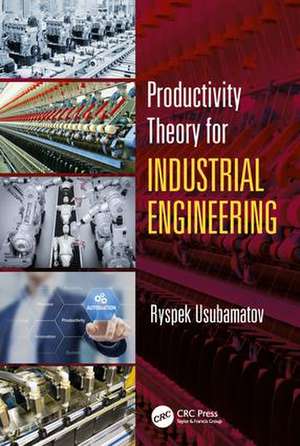Productivity Theory for Industrial Engineering: Systems Innovation Book Series
Autor Ryspek Usubamatoven Limba Engleză Hardback – 6 iun 2018
In the area of productivity theory for industrial engineering, there are numerous publications that describe the fundamental approaches and the mathematical models of productivity rate for the different designs of industrial machines and systems. Known theories consider the physical productivity rate as the number of products fabricated over a given time (ASME) that is a component of economic productivity. However, known mathematical models are simplified with assumptions and not well developed analytically, which can lead to severe errors in computing the output of manufacturing systems.
Modern industrial machines and systems are complex in design and in structure with serial, parallel, and serial-parallel arrangements, and any failure of any component leads to downtime of expensive production systems. For this reason, industries need a productivity theory that enables accurate predicting of the output of manufacturing systems at the preliminary stages.
Key features
- Offers fundamental principles of productivity theory for industrial machines and systems based on mathematics, technology, design, reliability, probability, and management
- Presents the conceptual principles of productivity theory for industrial machines and systems
- Provides methods for computing productivity losses in real industrial environments
- Closes the gap between theory and practice for computing productivity rates of manufacturing systems
- Incudes a comparative analysis of productivity rates for manufacturing systems of serial, parallel, and serial-parallel arrangements
| Toate formatele și edițiile | Preț | Express |
|---|---|---|
| Paperback (1) | 433.48 lei 6-8 săpt. | |
| CRC Press – 31 mar 2021 | 433.48 lei 6-8 săpt. | |
| Hardback (1) | 1109.18 lei 6-8 săpt. | |
| CRC Press – 6 iun 2018 | 1109.18 lei 6-8 săpt. |
Din seria Systems Innovation Book Series
-
 Preț: 344.38 lei
Preț: 344.38 lei -
 Preț: 378.44 lei
Preț: 378.44 lei -
 Preț: 442.12 lei
Preț: 442.12 lei -
 Preț: 356.29 lei
Preț: 356.29 lei - 8%
 Preț: 544.81 lei
Preț: 544.81 lei -
 Preț: 432.12 lei
Preț: 432.12 lei - 9%
 Preț: 361.58 lei
Preț: 361.58 lei - 18%
 Preț: 1274.95 lei
Preț: 1274.95 lei - 18%
 Preț: 1120.23 lei
Preț: 1120.23 lei -
 Preț: 436.14 lei
Preț: 436.14 lei - 15%
 Preț: 668.34 lei
Preț: 668.34 lei - 15%
 Preț: 613.49 lei
Preț: 613.49 lei - 30%
 Preț: 852.64 lei
Preț: 852.64 lei - 15%
 Preț: 545.64 lei
Preț: 545.64 lei -
 Preț: 431.35 lei
Preț: 431.35 lei -
 Preț: 436.14 lei
Preț: 436.14 lei -
 Preț: 456.94 lei
Preț: 456.94 lei - 25%
 Preț: 823.17 lei
Preț: 823.17 lei - 27%
 Preț: 426.67 lei
Preț: 426.67 lei - 25%
 Preț: 629.11 lei
Preț: 629.11 lei -
 Preț: 428.64 lei
Preț: 428.64 lei - 18%
 Preț: 789.54 lei
Preț: 789.54 lei -
 Preț: 421.23 lei
Preț: 421.23 lei - 15%
 Preț: 617.20 lei
Preț: 617.20 lei - 9%
 Preț: 591.61 lei
Preț: 591.61 lei - 31%
 Preț: 553.84 lei
Preț: 553.84 lei - 26%
 Preț: 352.95 lei
Preț: 352.95 lei - 15%
 Preț: 461.03 lei
Preț: 461.03 lei -
 Preț: 449.41 lei
Preț: 449.41 lei -
 Preț: 323.23 lei
Preț: 323.23 lei -
 Preț: 434.41 lei
Preț: 434.41 lei - 27%
 Preț: 351.68 lei
Preț: 351.68 lei - 18%
 Preț: 788.59 lei
Preț: 788.59 lei - 18%
 Preț: 1109.18 lei
Preț: 1109.18 lei - 27%
 Preț: 1229.82 lei
Preț: 1229.82 lei - 30%
 Preț: 768.69 lei
Preț: 768.69 lei
Preț: 1109.18 lei
Preț vechi: 1352.65 lei
-18% Nou
Puncte Express: 1664
Preț estimativ în valută:
212.25€ • 226.96$ • 176.96£
212.25€ • 226.96$ • 176.96£
Carte tipărită la comandă
Livrare economică 17 aprilie-01 mai
Preluare comenzi: 021 569.72.76
Specificații
ISBN-13: 9781138483217
ISBN-10: 1138483214
Pagini: 276
Ilustrații: 47 Tables, black and white; 111 Illustrations, black and white
Dimensiuni: 156 x 234 x 18 mm
Greutate: 0.45 kg
Ediția:1
Editura: CRC Press
Colecția CRC Press
Seria Systems Innovation Book Series
ISBN-10: 1138483214
Pagini: 276
Ilustrații: 47 Tables, black and white; 111 Illustrations, black and white
Dimensiuni: 156 x 234 x 18 mm
Greutate: 0.45 kg
Ediția:1
Editura: CRC Press
Colecția CRC Press
Seria Systems Innovation Book Series
Public țintă
Professional Practice & DevelopmentCuprins
1. Introduction to productivity theory for industrial engineering 2. Conceptual principles of productivity theory for industrial engineering 3. Manufacturing systems of parallel arrangement and productivity rate 4. Manufacturing systems of serial arrangement and productivity rate 5. Manufacturing systems of parallel–serial arrangement 6. Analysis of the work of industrial machines and systems at real manufacturing environment 7. Conclusion
Descriere
The basic attributes of industrial machines and systems are the productivity rates and quality of products. This book presents the mathematical models for optimization of machining regimes and optimization of the numbers of working stations for production lines of different structures by the criterion of maximal productivity rates.
